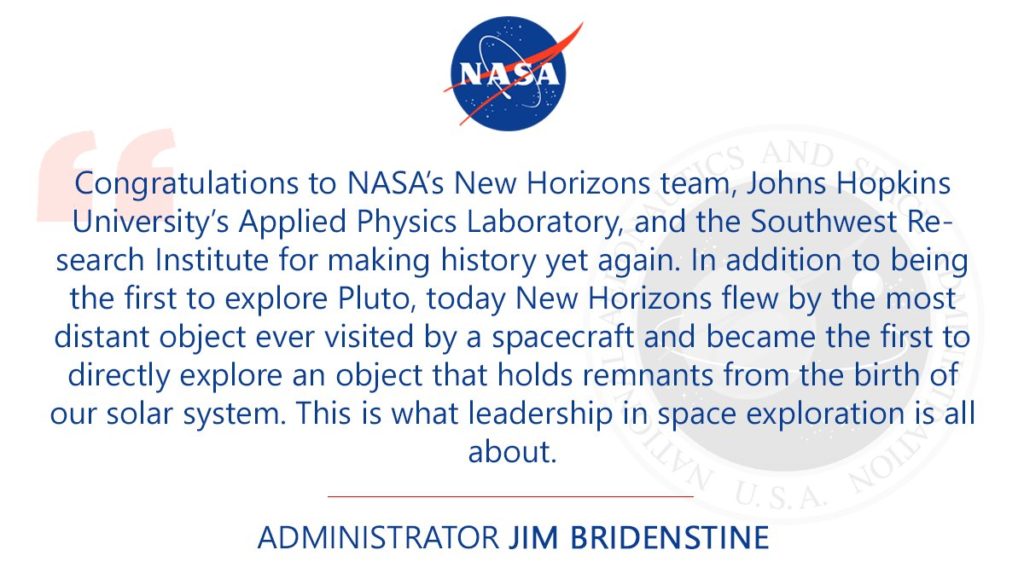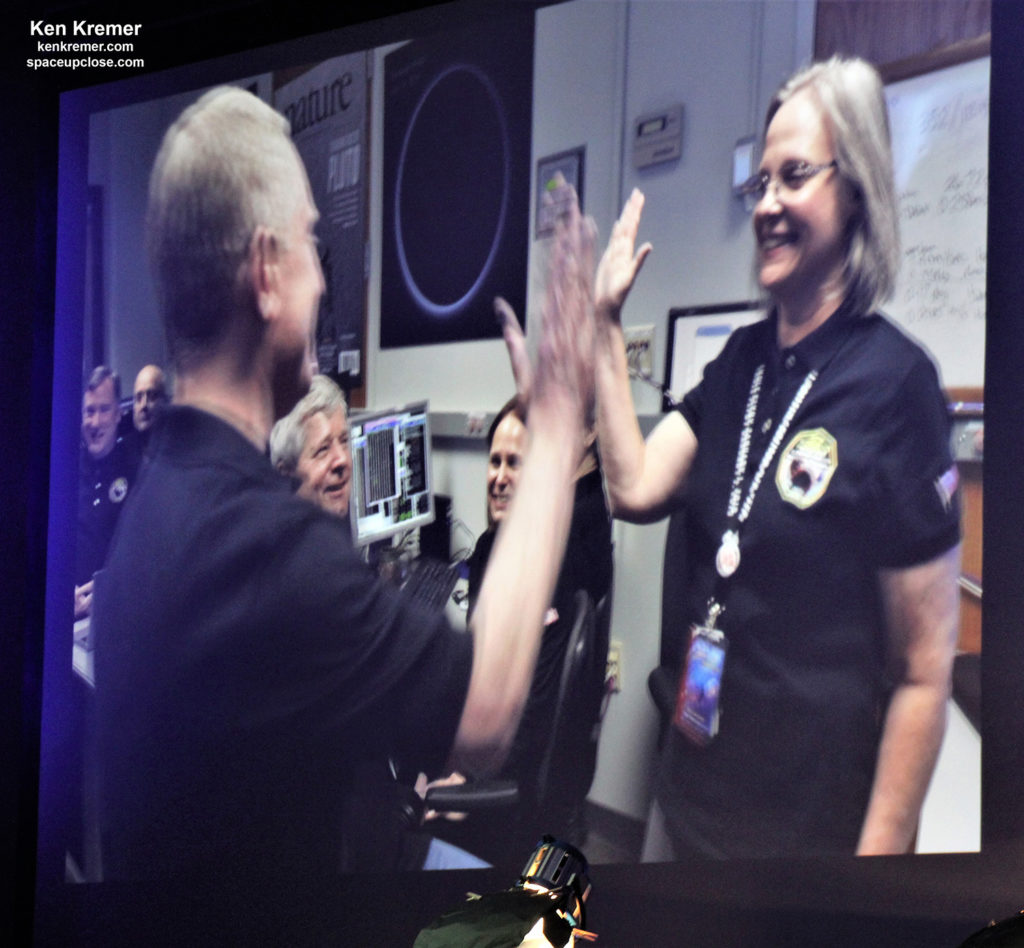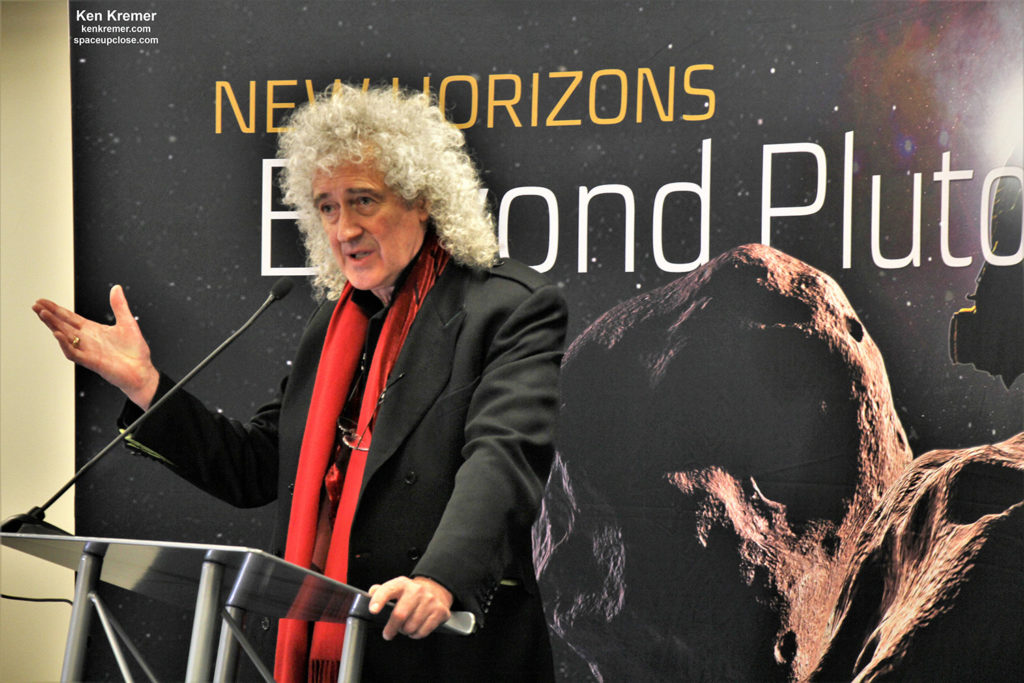RocketSTEM –1 January 2019
APPLIED PHYSICS LABORATORY, LAUREL, MD – NASA’s New Horizons spacecraft ‘Phoned Home’ this morning New Years Day 2019 precisely as planned after successfully conducting
a history making close flyby of the most distant object ever visited by an
emissary from humanity- located more than 4 Billion miles (6.5 billion km) from
Earth at a frozen world named ‘Ultima Thule.’
“We have a healthy
spacecraft, we’ve just accomplished the most distant flyby,” reported Alice
Bowman, the Mission Operations Manager (MOM) at the Johns Hopkins University Applied Physics Laboratory (JHU
APL), in Laurel, MD, after the successful acquisition of the ‘Phone Home’ signal at
about 10:31 a.m. EST.
Furthermore the mission
operations reported that the on board data recorders are FULL with SCIENCE !!!!
New Horizons
swooped past ‘Ultima Thule’ just past midnight today shortly after the dawn of New
Year’s Day 2019 at 12:33 a.m. EST as mission scientists, invited guests and the
media including Space UpClose were on hand to witness the groundbreaking events
first hand as they unfolded at the Johns Hopkins University
Applied Physics Laboratory, in Laurel, MD.
‘Ultima
Thule’ which means “beyond the known world” is a tiny bowling pin shaped rock no more than 20 miles (30 km) long located in the Kuiper Belt
and was selected because it has been virtually unchanged for eons and is key to
unlocking the mysteries of the origin and evolution of our Solar System since
its formation 4.5 Billion Years ago.
“New Horizons performed as planned today, conducting
the farthest exploration of any world in history — 4 billion miles from the
Sun,” said Principal Investigator Alan Stern, of the Southwest Research
Institute in Boulder, Colorado.
“The data we have look fantastic and we’re already
learning about Ultima from up close. From here out the data will just get
better and better!”
The team released a new composite image of Ultima today roughly
6 pixel resolution that still shows it as a fuzzy blob and elongated – about twice
as long as it is wide, said Project Scientist Hal Weaver of JHU APL.
Check out our
gallery of on site images from JHU APL throughout the flyby and close encounter
period.
who is also an official member of the science team composed a new song named simply
‘New Horizons’ and music video especially for the flyby at the request of PI
Dr. Alan Stern.
May released the astronomically awesome song during the
midnight countdown celebration attended
by hundreds at JHU APL leading up to the 12:33 a.m. EST
flyby (see my photos).
“This mission is about human curiosity,”
May said at a media briefing at JHU APL just hours before today’s flyby. “The
need of mankind to explore and see what makes the universe tick. My song is an
anthem to human endeavor.”
The piano sized
voyager was speeding at a velocity of 32,000 mph (9 miles
per second) and flew within at a distance of merely 2,200 miles (3,500
kilometers).
‘Ultima Thule’ is
a fossil remnant from the formation of the early solar system that has almost
certainly remained unchanged over time and thus represents our best chance to
study how we came to be some 4.5 Billion Years Ago.
Virtually nothing
is known about ‘Ultima Thule’! But that all changes today with the successful acquisition
of signal on New
Year’s Day 2019.
after closest approach the New Horizons spacecraft temporarily interrupted data
collection to turn around towards Earth and transmit a limited quantity of data
for about 15 minutes to confirm that the spacecraft was healthy and had collected
the huge amount of color and black and white images, as well as science gathering
measurements and observations amounting to roughly 50 GB of data.
as Bowman and her team reported out in real time – to the congratulations of PI
Anal Stern and the large crowd of team members, officials, guests and media gathered
at JHUAPL.
sized probe carried out the close flyby completely autonomously and operated to
gather data using its 66 pound (30 kg) suite of seven science instruments without
any possible intervention from Earth.
about 20 months to transit all that data back to Earth across the vast expanse
of 4 billion miles of space. It takes over 6 hours for the data to arrive traveling
at the speed of light.
“Congratulations to NASA’s New Horizons team, Johns
Hopkins Applied Physics Laboratory and the Southwest Research Institute for
making history yet again. In addition to being the first to explore Pluto,
today New Horizons flew by the most distant object ever visited by a spacecraft
and became the first to directly explore an object that holds remnants from the
birth of our solar system,” said NASA Administrator Jim Bridenstine, in a statement
of congratulations.
“This is what leadership in space exploration is all
about.”
unknown before the flyby.
Even today we know very little but more than
yesterday after the first semi resolved image taken just before the flyby was
returned across 4 billion miles of space to eagerly waiting scientists on
Earth.
It appears to be peanut shaped and might be bi
lobate spinning end over end, or be a binary as two separate bodies.
Its size is estimated at no more than 20 miles (30 kilometers) long and 10
miles (16 km) wide, or, if a binary, each about 9-12 miles (15-20 kilometers)
in diameter.
 |
|
Two possible rotation periods for Ultima Thule. Credit:
NASA/JHUAPL/SwRI |
“Ultima Thule is a great wonderland. It the
best preserved sample of pristine material ever visited. There is no geologic engine
for change, unlike Pluto,” says Stern.
The Ultima Thule flyby is historic in multiple respects.
Ultima Thule is likely the most primitive object ever
visited by any spacecraft in history.
It also counts as the farther planetary flyby encounter ever
conducted in history.
At today’s post flyby briefing I asked PI Alan
Stern, how common would it be for such a tiny object
as Ultima Thule (20 mi long) to actually be two seperate bodies vs
bi-lobate? “Unprecedented!” he replied.
“My bet would be it’s probably a single object,
it’s bilobate, and if I’m wrong I’ll tell you tomorrow,” Stern told Space
UpClose at the briefing.
“If it’s two separate objects, this would be an
unprecedented situation in terms of how close they’re orbiting to one another.
it would be spectacular to see, and I’d love to see it, but I think the higher
probability is it’s a single body.”
 |
|
New Horizons team members at the Jan 1, 2018 JHU APL press
briefing. Credit: Ken Kremer/kenkremer.com/spaceupclose.com |
New
Horizons has been hurtling towards the unexplored outer limits of our Solar
System since launching 13 years ago in Jan. 2006 and conducting the first up
close flyby of Pluto – the ninth planet – in July 2015.
Pluto, the largest known body in the Kuiper
Belt, was the first target explored by New Horizons during a fast flyby over three
years ago during July 2015.
 |
|
Global mosaic of Pluto created from raw images gathered
during July 2015 flyby by NASA’s New Horizons spacecraft. Credit: NASA/JHU/JPL/SWRI/Marco Di Lorenzo/Ken Kremer/kenkremer.com |
‘Ultima Thule’ is the second Kuiper Belt object that has now
been explored up close by New Horizons.
The small icy rock in the Kuiper Belt is located some 1 Billion
miles (1.6 Billion km) beyond Pluto and orbits 4.1 Billion miles (6.6 Billion
km) from the Sun and the Earth.
The New Horizons team tapped ‘Ultima Thule’ as the nickname
for the spacecrafts second flyby target on New Year’s Day 2019 – “symbolizing this ultimate exploration by NASA” says Alan
Stern, the missions team leader and chief scientist.
The primitive
frozen world – officially known as 2014 MU69 – has
now become the farthest object ever explored up close by a manmade emissary
in history when NASA’s New Horizons spaceship zoomed past for a close encounter
on Jan. 1, 2019 orbiting more than a billion miles
beyond Pluto, the most distant planet in our Solar System.
first ever up close examination of this distant object holds critical clues to
the formation of the outer solar system eons ago.
Stern
says New Horizons spacecraft is performing perfectly and all systems and
subsystems are just as good as the day they were launched in Jan. 2006 on a ULA
Atlas V rocket.
It
has enough power to operate through the mid-2030’s at least and can conduct a
third flyby.
The
team says they will begin that search immediately using the LORRI camera and
propose an extended mission to NASA in the summer of 2020.
 |
|
NASA New Horizons spacecraft
trajectory since launching from Earth on Jan. 19, 2006 on ULA Atlas V rocket. Credit: NASA/JHUAPL/SWRI |
Watch
for Ken’s continuing onsite coverage direct from JHU APL.
Watch
for Ken’s continuing onsite coverage of NASA, SpaceX, ULA, Boeing, Lockheed Martin,
Northrop Grumman and more space and mission reports direct from the Kennedy Space
Center, Cape Canaveral Air Force Station, Florida and Wallops Flight Facility,
Virginia.
and human spaceflight news: www.kenkremer.com –www.spaceupclose.com – twitter
@ken_kremer – email: ken at kenkremer.com
Dr. Kremer is a research scientist,
journalist and photographer based in the KSC area.
Ken’s photos are for sale and he is available for lectures and outreach events








